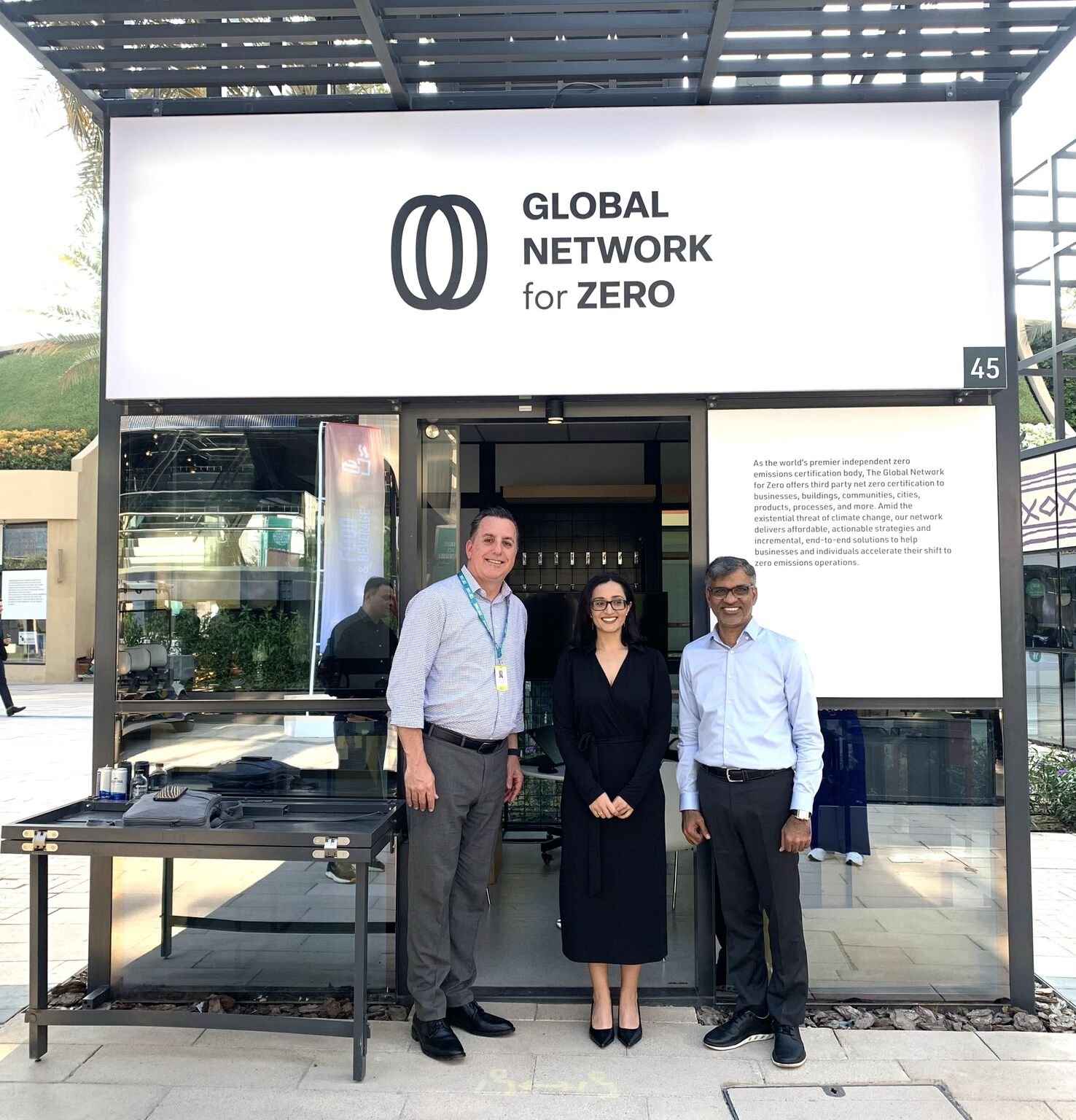From Dubai, to Davos and Beyond: Lessons From COP28 and The Missing Ingredient for Building a Decarbonized World
Earlier this month, at the heart of the action in Dubai, I witnessed firsthand a number of commitments and announcements with regard to decarbonization and the building sector. And while these multinational initiatives certainly show promise for the months and years ahead, there’s still one missing key ingredient, one approach that feels consistently like an afterthought even when it comes to the most relevant and outspoken advocates for a decarbonized future.
Key COP28 Announcements
We were honored that GNFZ was competitively selected to participate in COP’s ambitious new climate-tech startup village in the Green Zone this year, where we were able to host conversations and demonstrate our vision for a net zero future through our net zero certification process.
In addition, GNFZ’s leadership was particularly heartened by the launch of the Buildings Breakthrough, a strategy from the Governments of France and Morocco, the UN Environment Programme (UNEP) for ensuring near-zero emissions and climate resilient buildings are, as they say, “the new normal by 2030.” With more than 27 countries committing to the Breakthrough, I was inspired to see a renewed focus on creating more robust zero emissions frameworks for the highest emitting sectors.
Some other key announcements worth noting include the Green Public Procurement Pledge, in which a coalition of countries committed to drive demand for low-emissions steel, cement and concrete through public procurement; the Industrial Deep Decarbonization Initiative, where Canada, Germany, the UK and the US announced significant timeline-bound commitments to procure low emission steel, cement and concrete, and to set emissions reduction thresholds for whole project life cycle assessments (LCAs) to achieve net zero emissions in public buildings and infrastructure; the Net-Zero Data Public Utility, a centralized repository of global company level GHG emissions data; and last but not least, the Global Decarbonization Accelerator, in which 118 governments committed to tripling renewables and doubling the rate of energy efficiency improvements by 2030.
So what’s still missing?
At the end of the day, all this momentum is great – but it still begs the question: What is going to cut it?
Globally, we’re still at only a few hundred net zero buildings. The market continues to focus on the marquee buildings — on big, legacy showpieces that can be touted as the “largest net zero building,” or “biggest net zero commitment,” or only “net zero structure of this scope.” Those projects count. These higher performing buildings are a necessary model. They matter, and they take significant effort and collaboration to accomplish — but what they don’t do is further a collective goal of reaching net zero at scale.
I've seen this firsthand. Despite three decades of green building efforts, we only have 100,000 or so green buildings globally. And with the current top-down strategy where we target the elite 5-10% of the market and hope the rest follows, the industry isn’t tapping into the extraordinary potential possible with incrementalism.
To achieve true scalability, we need an incremental approach that provides the broader market with a roadmap to zero. We can no longer afford to be overly rigid, overbearing or excessively holistic in our expectations — as this is what is keeping many from even beginning their net zero journey.
What’s next
Buildings represent the highest emitting sector in the world — so if incrementalism is the missing ingredient to scaling a net zero building sector, then it’s also the first key to scaling a net zero world.
Say it with me: Averting an existential crisis requires net zero transformation at scale. And scale is only possible with an incremental approach to acceleration.
In order to tap into that approach, we have to examine why, in the past, making genuine progress toward a net zero world has felt so elusive — and how our response this time around can and must be different:
There are so many strategies and certifications available, that often it’s difficult to understand what tactics will scale. Knowing that, we need an outcome-based approach, ROI data, and a replicable model.
We’re well past standard saturation. We have to harmonize standards — making it less confusing and easier for people to achieve awareness, adoption and ultimately incremental acceleration of decarbonization.
We’re relying on an unreliable savior. We can no longer expect that mega-funding like the IRA or policy mandates is guaranteed. Government leadership changes, which means so does policy. Independent from the geopolitical landscape, we must ensure the private sector continues to transform its assets for the long term.
Scope 3 emissions is a critical outlier that the building sector needs to address, especially because embodied energy and carbon are tied to it. We must focus on incremental solutions for Scope 3 elimination to happen at scale.
GNFZ’S mission
We like to say we’re putting net zero within reach for all — because we are. As the world’s premier independent net zero certification body, GNFZ is addressing these traditional barriers to decarbonization by ensuring individuals and organizations can start anywhere and end at zero. And we’re doing this with a specific focus on that missing key ingredient of incrementalism.
Based on the GHG Protocol — a global framework for measuring, managing and reducing emissions from private and public sector operations, value chains, products, cities and policies — GNFZ’s certification is rating system agnostic, aligns with the Paris Agreement and provides an incremental path to calculate and eliminate Scope 1, 2 and 3 emissions.
And with multiple recognition benchmarks throughout the certification process, GNFZ enables clients to demonstrate their incremental progress toward emissions reduction and elimination to key stakeholders.
In fact, our all-in-one solutions for incrementally reaching net zero targets are designed with a three-pronged commitment to ensure greater affordability, accessibility and acceleration, and to keep our promise of leaving no building or business behind.
I hope you’ll join our journey at GNFZ in 2024. Because while I was thrilled to hear about the initiatives announced during this year’s COP28, it’s just as important to recognize and reflect on why it’s not enough.
And as leaders gather for the World Economic Forum in Davos next month, and for future climate gatherings in 2024, I’m committed to ensuring GNFZ plays a pivotal role in bringing more people and organizations into the fold, in highlighting the impact of incrementalism and, at long last, in driving the democratization of a decarbonized world.


